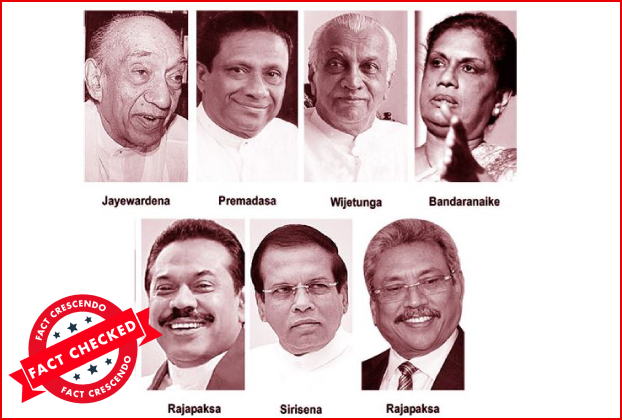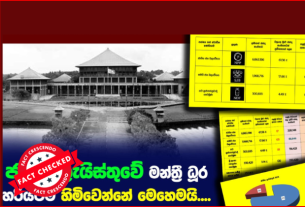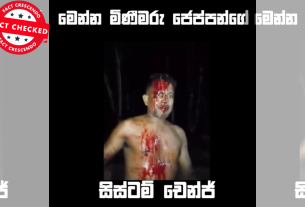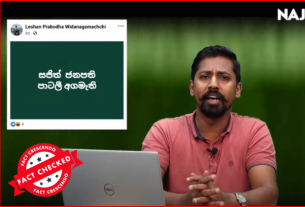Although a large number of candidates compete at the presidential election, in most cases it has become a contest between two major candidates. The Presidential Election is conducted under a preference order system. Thus, a voter can vote for one candidate of his choice or three candidates in the order of his choice.
According to the voter’s choice, the voter can vote only for one candidate, by marking his choice with the ‘X’ mark or the voter can vote for three candidates by marking his choice as ‘1’, ‘2’, and ‘3’ according to his preference order.
However, 39 candidates have given nominations for the presidential election this year and they will compete on 21st of September, under the longest ballot in history.
It is crucial to focus on the low rates of votes that most of the candidates obtain, in a situation where there are so many candidates contesting for the Presidential Election. In order to analyze this, given below is an extended report of the votes obtained at past Presidential Elections in Sri Lanka.
Presidential Election – 1982 (First)
Six candidates contested at the First Presidential Election, while more than 81% of the registered voters casted their vote. J. R. Jayawardene who represented the United National Party won the Election by obtaining 52.91% and became the first Executive President of Sri Lanka. Hector Kobbekaduwa of the Sri Lanka Freedom Party obtained 39.07% of votes while Rohana Wijeweera of Janatha Vimukthi Peramuna obtained a total of 273,428 votes and a 4.19 of a percentage.
Kumar Ponnambalam who represented the All Ceylon Tamil Congress obtained a 2.67% of votes. Colvin R. de Silva from the Lanka Sama Samaja Pakshaya and Vasudeva Nanayakkara from the Nava Sama Samaja Party also obtained a small percentage of votes. You can refer to more information here.
Presidential Election – 1988
Ranasinghe Premadasa, who started the Presidential Campaign, won the election by getting 50.43%. Sirimavo Banadaranaike obtained 44.95% of votes and Oswin Abeygunasekara got 4.63% votes. Only 55.32% of registered voters casted their votes at the Election. This led to a terror that broke out across the country, and it made history as the Presidential Election with the lowest voter turnout. You can refer to more information here.
Presidential Election – 1994
Chandrika Bandaranaike from People’s Alliance, obtained 47,09,205 which is 62.28% of votes. It is recorded as the highest percentage obtained at a Presidential Election in Sri Lanka. None of the candidates who have contested so far managed to exceed 60% of the votes. And it was in the 1994 Presidential Election that women contested as candidates.
Srima Dissanayake from the United National Party obtained 27,15,283 votes which is 35.91%. Hudson Samarasinghe who was an individual candidate could obtain only 0.78% of votes. You can refer to more information here.
Harischandra Wijayathunga from Sinhalaye Mahasammatha Bhoomiputra Pakshaya obtaines 0.43% of votes while an individual candidate: A.J. Ranasinghe and Nihal Galappaththi from Sri Lanka Progressive Front obtained an amount of 0.30%. There was a huge gap between the obtained votes among the two candidates who contested from the major parties and other candidates.
Presidential Election – 1999
From the Presidential Election held on 21st December 1999, Chandrika Bandaranaike obtained 51.12% of votes while Ranil Wickramasinghe from the United National Party obtained 42.71% of votes. Nandana Gunathilake from Janatha Vimukthi Peramuna obtained 4.08% of the votes, while no other candidates could cross 1% of the votes. More information here.
Presidential Election – 2005
Chandrika Bandaranaike Kumarathunga filed a petition in the Supreme court saying that since the Presidential Election was held a year before its actual time period, it should be added to her second term. However, the court dismissed the petition and ordered the Presidential Election to be held.
Ranil Wickramasinghe contested from the United National Party while Mahinda Rajapaksa contested from the Sri Lanka Freedom Party. The Janatha Vimukthi Peramuna and the National Hela Urumaya allied with the Sri Lanka Freedom Party and supported Mahinda Rajapakshe on the promises of rejecting a federal system and holding peace agreement talks with the LTTE.
Meanwhile, the Sri Lankan muslim Congress and the Tamil Parties representing the estates expressed their support to Ranil Wickramasinghe.
In this election, which was a very sharp contest, Mahinda Rajapaksa, who presented the “Mahinda Chinthana” policy series, won with a 50.29% of the votes. Ranil Wickramasinghe obtained 48.43% of votes while the third candidate Sirithunga Jayasuriya from the United Socialist Party obtained 0.36% of votes. The fourth and fifth candidates who are A.A. Suraweera and Victor Hettigoda obtained 0.32% and 0.15% of votes, respectively. More information here.
Presidential Election – 2010
The President, Mahinda Rajapakshe, was extremely popular as he managed to defeat the LTTE military after a fierce fighting that lasted until 2009. Due to this he called another Presidential Election, a year before the scheduled term.
A common candidate was presented for the Presidential Election by the combination of several opposition parties. With the support of the United National Party and the Janatha Vimukthi Peramuna, former Army Commander General Sarath Fonseka entered the Presidential Election as the common candidate under the swan symbol.
This election was more heated than the previous elections due to the battle between two main candidates who shouldered the war victors. However, Mahinda Rajapaksha easily won the Presidential Election with a 57.88% of votes. So far, every president has seen a decrease in the percentage of votes he receives in his second term compared to his first term, but this time there was a change.
While General Sarath Fonseka obtained 40.15% of the votes, the third candidate, Mohammad Kasim Mihammad Ismail, obtained 0.38% of votes. Also, Achala Ashoka Suraweera and Channa Janaka Sugathasiri who were the 4th and the 5th candidates, obtained 0.25% and 0.22% of votes, respectively. More information here.
In the 2010 Presidential Election, the overall voting percentage was 74%, but the percentage of voting in Jaffna and Wanni districts were 25.66% and 40.33% respectively. This was due to the displacement of the people and the loss of identity cards as a result of the war.
There were 22 candidates who contested in the election and it was the most contested Presidential Election in history. Except for Mahinda Rajapaksha and Sarath Fonseka, all the other candidates could get only 1.97% of votes. Due to this, the deposits of all the 20 candidates were confiscated.
Presidential Election – 2015
Mahinda Rajapaksha called an early Presidential Election hoping to extend his tenure once again. He represented the United People’s Freedom Alliance.
However, this time also a common candidate was presented by a combination of several parties including the United National Party. That candidate was Maithripala Sirisena, who was the Minister of Health in the Mahinda Rajapaksha regime and the secretary of the Sri Lanka Freedom Party.
S
After a strong contest, Maithripala Sirisena won the Presidential Election with 62,17,162 votes and a percentage of 51.28%. He released his manifesto, titled “A compassionate Maithri Government, a stable country. Mahinda Rajapaksha obtained 47.58% of votes. The candidates who contested as the 3rd, 4th and 5th candidate, who were A.R. Sirisena, Namal Rjapaksha and Ibrahim Mifler obtained 0.15%, 0.13% and 0.12% respectively. In the Presidential Election where 19 candidates contested, none of them could cross the 0.15% limit except for the two frontrunners. More information here.
Presidential Election – 2019
The number of rejected votes in the 2019 Presidential Election was really significant and it was 135,452 votes. As a percentage it was 0.857%. Although the total number of registered voters was 15,992.096, only 13,387,951 people voted. It took a high value of 83.72% as a percentage.
Some names were registered at the election as an alternative if the name of the major parties unexpectedly dropped out during the acceptance of nominations. Other candidates came forward with the aim of adding their name to the history of the competition. Others came forward to break the votes of the candidate who they thought is the main opponent. Total number of candidates was 35.
Gotabaya Rajapaksha, who was elected as the president, won the presidential election by obtaining 52.25% of valid votes, while his main opponents, Minister Sajith Premadasa, obtained only 41.99% of votes. Anura Kumara Dissanayake of the Nation People’s Power got the third place with only 4.2% of the total number of valid votes. Mahesh Senanayke obtained 0.39% of votes while M.A.L.A.M. Hizbullah obtained 0.29% of votes. More information here.
As the presidential election draws nearer, more and more candidates will join and all of them will get some small amount of votes. This can be further analyzed according to how it has happened so far.
It can be understood, with the 2019 Presidential Election as well. Aparakke Punnananda Thero, S. Amarasinghe, Iddis Mohammad Illya, A.H.M. Alavi, appeared as independent 1 to 4th candidate respectively. Also Ariyawansa Dissanayake, A.M. Edirisinghe, Sarath Keerthirathna, Koralage Samansiri, Sirithunga Jayasooriya, Ajantha de Soysa, Aruna de Soysa, Duminda Nagamuwa, Rohan Pallewaththa, Jayantha Katagoda, Sman Perera, Anuruddha Polgampola, Milroy Fernando, Baththaramulle Seelarathana Thero, Baddegama Nandimithra, Sarath Manamendra, M.K. Sivajilingam, M.L.A.M. Hizbullah, Namal Rajapaksha, A.S.P. Liyanage, Ashika Wadigamangawa, Piyasiri Wijenayake, Ajantha Perera, Rajiv Wijesinghe, Samaraweera Weerawanthi, Subramaniyam Gunarathnam, Mahesh Senanayke were other candidates, and their obtained percentage at the election was very low.
Sri Lankans are once again preparing for a Presidential Election. The person who won in the last seven presidential elections got more than 50% of the votes. If not, the second preference of the candidate who won the second position and other candidates should have been counted.
Thus, in observing the results of presidential elections in history, it is clear that, except for a handful of early candidates, the rest of the candidates received a very low percentage of the total votes.






